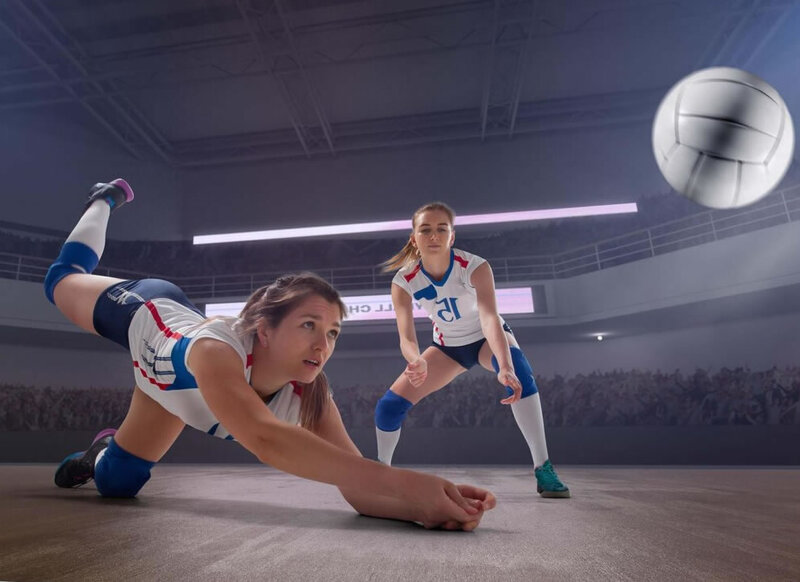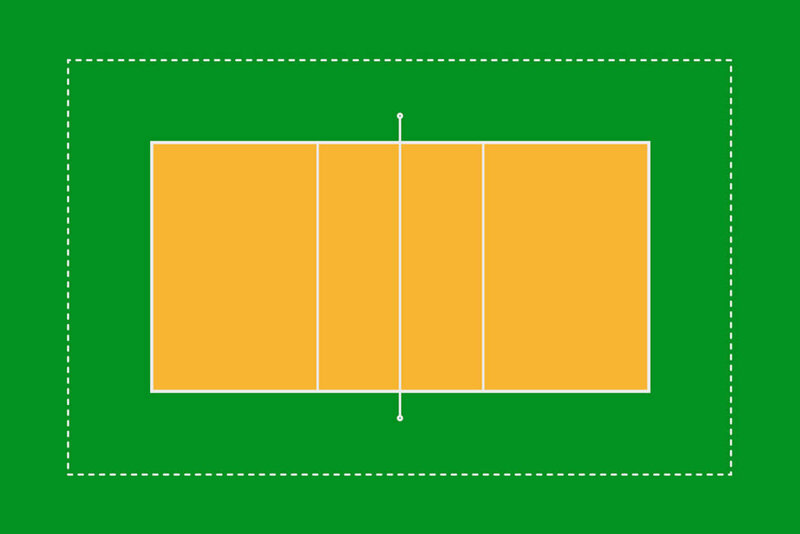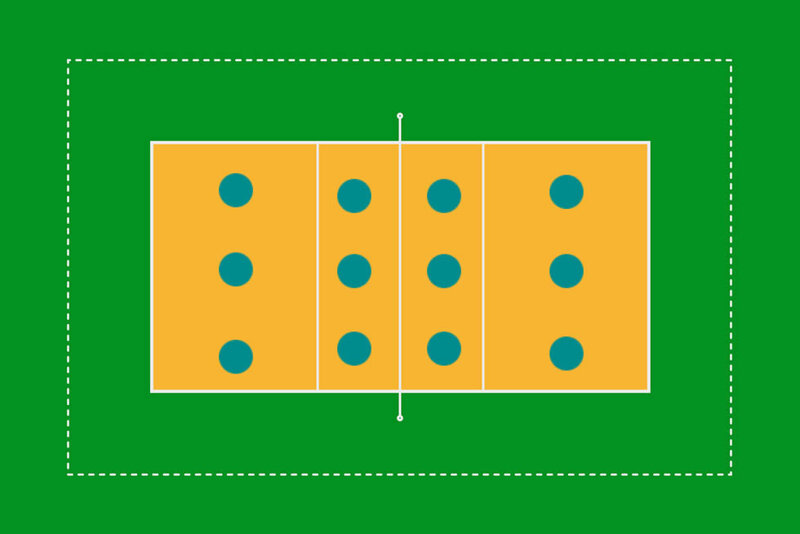Volleyball Rules
Volleyball is a team sport where two teams of 6 active players compete against each other. The objective is to get the ball over a net and onto the opponent's court.
When the game begins with a serve, the ball is hit from one side of the court to the opponent's in a long shot. The opposing team has "3 point-touches" (they can touch the ball 3 times) to defend their court and return the ball over the net.
Points are scored if the ball lands on the opponent's court or if they commit a fault.
During play, players continuously rotate (clockwise), so no player stays in the same position all the time, and all players move around the court. Each team has a "substitute" placed in the back positions. This substitute is called a LIBERO and wears a different uniform.
Let's take a closer look at the rules.

Volleyball Court
- The court must be 18 meters long and 9 meters wide. Surrounding the court is a free zone where players can run during play, but no points are awarded if the ball hits the floor in this zone.
- The free zone must be 5.0 meters to the sides and 6.5 meters behind.
- The net should be 2.43 meters high, with an "antenna" on each side aligned with the court lines, making it easy to see if the ball is out of bounds.

The Important Center Line
- On each side of the court, is a line placed 3 meters from the net, called the 3-meter line.
- The back players must not cross this line but can dive into the zone as long as they land after the ball has left their hands. The purpose of this line is to keep the back players behind, so the team's best spiker can't just run forward all the time, creating more dynamics in the game and forcing the team to cooperate more.
Attire / Uniform
- There are specific rules for how player numbers should be designed, primarily to make them easy to see.
- Numbers must be 15 cm high in the front, placed in the center of the chest, and 20 cm in the back, also centered.
- The stroke of the number must be 2 cm wide.
- The captain's number must be underlined.
- The colors must naturally be in high contrast, so the numbers are easy to see on the shirts.
- Shoes must be without heels and made of soft rubber.
- The referee can allow play in bare feet, in suits if it is cold, or the changing of wet suits.
Team Captain
- The captain must present the team to the referee on a match sheet.
- When the captain is on the court, they automatically act as the game captain, and when the captain is not on the court, another player must be chosen as the game captain—either by the captain or the coach (not the libero).
- Only the game captain may speak to the referee during the game.
Coin Toss Before the Game
- The two captains toss a coin before the game starts, and the winner gets the right to choose:
- Whether they want to start serving or not, or
- Which side of the court they want to start on (not both).
Team Line-Up in Volleyball
- There must be at least 6 players on each side of the court during the entire game.
- Once the match sheet is submitted to the referee, the line-up cannot be changed during the game, except for rotation at each set and the substitution of the libero player.
- If there is an error in the line-up compared to the submitted sheet, it can be changed without penalties before the game starts, but if the game has started, the team will be penalized by deducting all points scored with the incorrect line-up + 1 point awarded to the opposing team.
- The opposing team is given the right to serve.

Positions on the Court
- The 6 players are divided into 3 front players (left, middle, right) and 3 back players (also left, middle, right).
- The wing players must work together so that the back players are at least one foot closer to the right/left side of the court (so the back player is always further out toward the line compared to the net player) and always at least one foot further away from the middle.
- This creates a cone-shaped formation that is widest at the back.
- This is the initial set-up—once the serve is made, players can freely move around the court.
Position Errors
- If the team is not correctly positioned during the serve, it is penalized with the loss of a point, and the serve is transferred to the opposing team.
Rotation
- Each time the right to serve is won, the team rotates one position clockwise.
- In case of a rotation error, the serve is transferred to the opposing team + 1 point.
The Volleyball Game Itself
Ball in Play
- The ball is in play when the referee has approved the serve and it is served.
Ball Out
- The ball is out when it is 100% outside the boundary lines
- or if it hits objects outside the court, such as other people or objects.
- or if it touches the antennas, poles, ropes/wires, and the net outside the sidelines.
- or if it passes under the net/outside the net area (outside the antennas).
Ball Touch
- There can be 3 touches in addition to a block.
- After a serve, a block is allowed, and then a maximum of 3 touches.
- The ball can be touched with any part of the body, including the buttocks, elbows, head, feet, etc.
- The same player may not touch the ball twice in a row.
- If three or two players touch the ball simultaneously, it counts as three or two touches.
- If touched in two places on the body simultaneously, it counts as a single touch.
- On the first touch on the court, the ball may touch several parts of the body consecutively as part of a single play, such as hands and then nose.
Touch Errors – What is Not Allowed in Volleyball
- The ball may not be caught.
- The ball may not be touched with 4 touches before it leaves the court.
- The ball may not be touched by the same player twice in a row.
- If the ball hits the net, it can still be played as long as the three touches are not used up.
- The ball can touch the net when passing over it.
Can You Cross the Center and Touch the Net?
- It is allowed to swing arms and legs over the net after a shot, as long as it does not interfere with the opponent's play.
- The same applies under the net, where it is also allowed to be on the opponent's court as long as the foot is kept on the centerline.
- It is allowed to touch the opponent's court with any part of the body (above the feet) as long as it does not interfere with the opponent's play.
- For example, it is allowed for a player to fall over the center with their hands.
- It is legal to enter the opponent's free zone, provided it does not interfere with the opponent's play.
- The net must not be touched by players (between the antennas), only by the ball (if a ball is shot so hard into the net that the net is forced onto an opponent, it is not a fault).
- Players may touch the net poles, ropes/wires, etc., outside the antennas.
- A player must not touch other players or the ball on their side of the court.
Scoring Points
- By hitting the ball onto the floor of the opponent's court.
- When the opposing team commits a fault.
- Play periods are defined by the ball ending its play either by hitting the floor, going out, or a fault being committed.
- 1 point is awarded per won play period, and play continues to 25 points with a lead of at least two points. If both teams reach 25 points, play continues until one team is two points ahead. Winning 3 sets wins the match. If tied after 4 sets, a deciding 5th set is played.
- The 5th set is played to 15 points and must be won by 2 points.
Libero Player
- The libero player can be substituted in the back three positions.
- It is common for one or more of the best net players to be substituted when it is their turn to be in the back by a player who is particularly good in that position, such as serving.
- This is often a player who is extremely fast and not as tall as a traditional net player (read more below).
Blocking in Volleyball
- Blocking is when net players jump up and block with their hands to make it difficult for the opposing team to spike or shoot the ball over. Only net players may block.
- Blocking must not be performed on the opponent's court.
- Blocking may result in hands coming over the net as long as the ball first touches their side of the net.
- The ball may be touched multiple times per block and player as part of a single action, such as an arm hit that causes the ball to hit the player's own head.
- Touching during blocking does not count as one of the three allowable touches when the ball comes over the net despite the blocking attempt.
Timeout and Substitution
- Each team is allowed two timeouts (30 seconds) and six substitutions per set. The coach, or the captain in the coach's absence, may request a timeout or substitution when the ball is not in play.
- Multiple players can be substituted at the same time (both must enter the substitution zone), without it counting as multiple substitutions.
- Technical timeouts are not taken in the 5th set, but 2 timeouts of 30 seconds may be requested. Technical timeout = when points 8 and 16 are reached in a set, a technical timeout of 60 seconds is taken (FIVB rules). All substitutions (including extraordinary ones) must be recorded on the match sheet.
Extraordinary Substitution – Due to Injury
- If a player cannot continue, the substitution does not count towards the 6 substitutions, and reserve players may take the place – Libero or other libero players are NOT allowed to take the injured player's position. The player who is unable to continue, whether due to injury or discomfort, must not be reinserted later in the match.
Breaks Between Sets
- In volleyball, there are no long breaks as in soccer; there are only 3 minutes between each set, and a request can be made for a special 10-minute break between sets 2 and 3.
Libero Player
- Only one libero may be on the court at a time.
- The libero may only play in the back three positions.
- The libero may not serve, block, or even attempt to block.
- The libero's substitution does not count as a regular substitution and can be substituted in/out at the end of each play period.
- When the libero is substituted out, only the player on the position or another libero may replace them.
- At the start of each set, the libero must not enter the court until the second referee has approved the match sheet and the line-up.
- Substitution of the libero must only be performed in the libero replacement zone; this is where the player must enter the court.
- The coach may declare a libero unfit to play and replace them with a new one, chosen from the reserve players. This is not allowed if the team had two liberos noted on the match sheet from the beginning.
- The team must continue with the remaining libero. If this libero becomes unfit to play, a new libero may be designated.